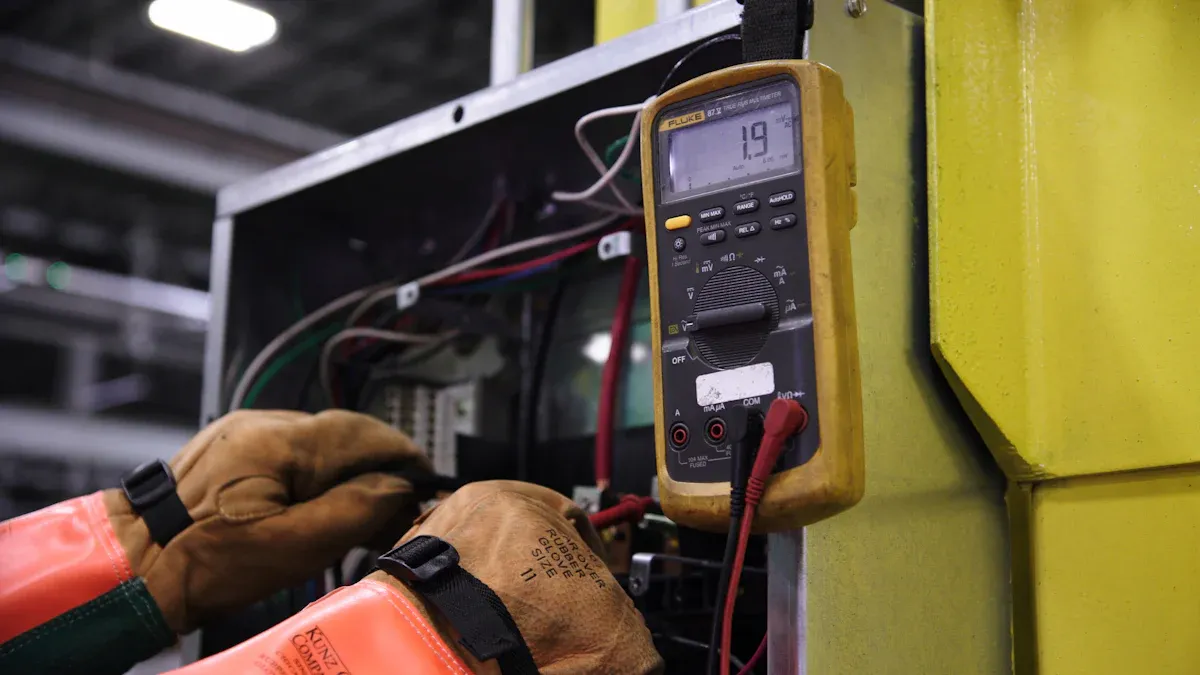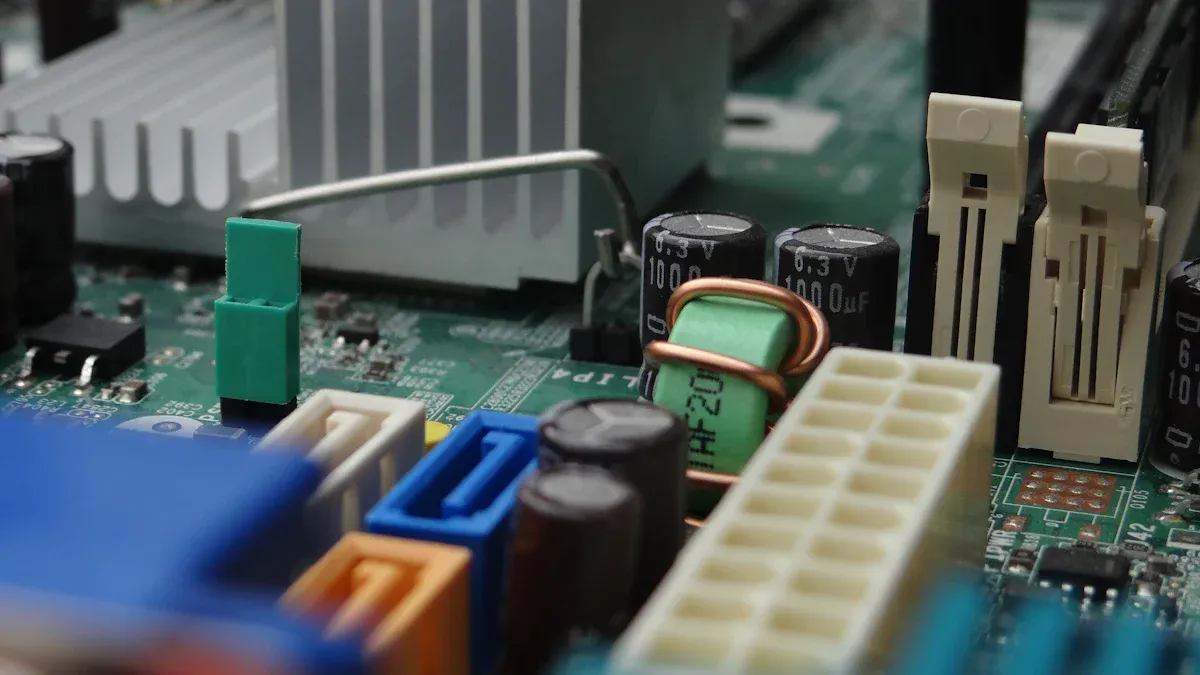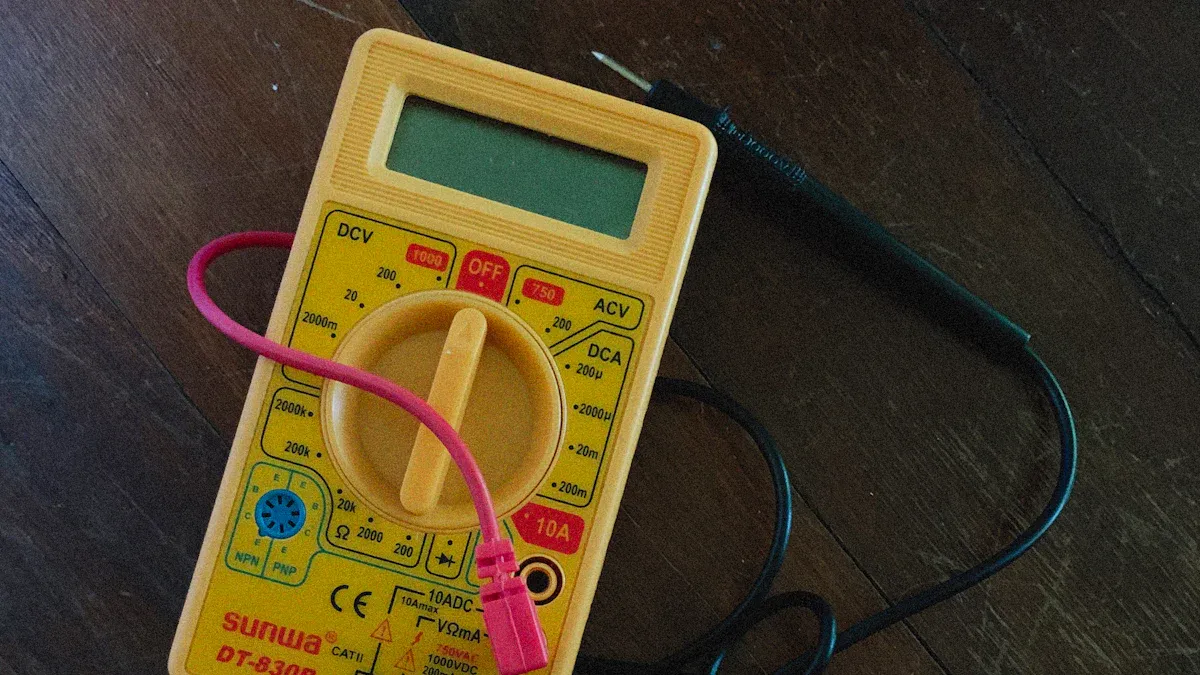What Is a Low Dropout Regulator Chip and How Does It Work

A Low Dropout Regulators chip helps you keep your electronic devices running smoothly by making sure the output voltage stays steady, even if the input voltage is only a little higher than what you need. You can rely on this chip for efficient power management because it uses very little energy—its quiescent current averages just 44.7 nA. The chip’s small size, only 0.03 mm², fits well in compact devices. Take a look at the table below to see how precise and efficient a typical LDO chip can be:
Metric | Value | What It Means |
|---|---|---|
Quiescent Current | 44.7 nA | Uses very little power |
Chip Area | 0.03 mm² | Fits into very small spaces |
Line Regulation | 9.5 mV/V | Keeps voltage stable as input changes |
Key Takeaways
Low Dropout Regulator (LDO) chips keep voltage steady even when input voltage is just slightly higher than output, saving power and reducing heat.
LDOs use a feedback system and a pass transistor to quickly adjust voltage, protecting sensitive electronics from changes.
Key factors to check when choosing an LDO include dropout voltage, quiescent current, efficiency, and output noise for best performance.
LDOs offer simple design, low noise, and small size, making them ideal for battery-powered and noise-sensitive devices like phones and sensors.
Always consider thermal management and device needs when selecting an LDO to ensure reliable and efficient operation.
Low Dropout Regulators Chip Basics

What Is an LDO
A Low Dropout Regulators chip is a special type of voltage regulator. You use it when you need to keep the output voltage steady, even if the input voltage is only a little higher than the output. This chip stands out because it can work with a very small difference between input and output voltages, sometimes less than 1 volt. That makes it different from standard linear regulators, which usually need a bigger gap to work well.
Tip: If you want to save power and reduce heat in your device, choosing a Low Dropout Regulators chip can help. It works well in small gadgets where space and energy matter.
You will find that technical guides, like the Toshiba Semiconductor e-learning series, explain these basics in detail. They show how the chip acts as a linear voltage regulator and why the low input-output difference is important. Articles from companies like Analog Devices and ROHM also describe how LDOs help lower power use and keep your circuits safe from voltage swings.
LDOs come in many types, such as low-noise, low-power, high-voltage, and high-power versions.
You can check datasheets and application notes to see which LDO fits your needs best.
Core Function
The main job of a Low Dropout Regulators chip is to keep the output voltage stable, even when the input voltage drops close to the output level. You rely on this chip to protect sensitive electronics from voltage changes. It uses a special design with an error amplifier and a pass element, like a transistor, to watch the output and adjust it quickly.
You will notice that the core function of an LDO is to provide a low-noise, steady voltage. This is important for devices like smartphones, sensors, and audio equipment. The chip uses a feedback loop to compare the output voltage to a set value. If the output drops, the chip reacts fast to bring it back up.
LDOs can lose some efficiency because of the small voltage difference they must handle, but new designs use tricks like VIOC technology to improve this.
For example, when the input voltage is about 5V and the dropout is 1.7V, the efficiency is around 67%. If you lower the dropout to 0.6V, the efficiency can jump to 84%.
You can find these details in technical articles and datasheets, which show how LDOs balance low noise and fast response with power savings.
Note: The feedback system inside an LDO helps you get a reliable voltage, even if your power source is not perfect. This makes the Low Dropout Regulators chip a key part of many modern electronic designs.
How LDOs Work
Internal Components
When you look inside a Low Dropout Regulators chip, you find several important parts working together. The main component is the pass transistor. This transistor acts like a gatekeeper for the electrical current. You will usually see either a Bipolar Junction Transistor (BJT) or a Metal-Oxide-Semiconductor Field-Effect Transistor (MOSFET) used for this job.
The pass transistor sits between the input and output. It controls how much voltage passes through.
An error amplifier checks the output voltage and compares it to a reference value.
The reference voltage sets the target for the output.
A feedback network connects the output back to the error amplifier.
Sometimes, you find extra circuits that help reduce noise or improve stability.
The pass transistor works in its linear region. This means it does not fully turn on or off. Instead, it adjusts smoothly to keep the output steady. For example, in some designs like the 78x05 series, you find BJTs as the pass element. In others, such as the LP2981, MOSFETs take this role. Each type has its own strengths. BJTs handle higher currents well, while MOSFETs respond quickly and use less control current.
The pass transistor’s resistance causes some power loss. The bigger the voltage drop and the higher the current, the more heat the chip makes. You need to consider this when choosing an LDO for your project.
Feedback Mechanism
The feedback mechanism is the heart of how an LDO keeps your voltage stable. Here’s how it works:
The error amplifier constantly checks the output voltage.
If the output drops below the set value, the amplifier tells the pass transistor to let more current through.
If the output rises too high, the amplifier reduces the current flow.
This loop happens very quickly, so your device always gets the right voltage.
You benefit from this fast feedback because it protects sensitive electronics from sudden changes. Some advanced LDOs use special features to make this process even better. For example, the LT3045-1 LDO uses a Voltage for Input-to-Output Control (VIOC) feature. This feature helps the feedback system by controlling the voltage before it even reaches the LDO stage. As a result, the chip does not have to work as hard to keep the output steady. This reduces wasted energy and keeps the chip cooler.
A strong feedback loop means your device gets a clean, stable voltage, even if the input power is not perfect. This is why the feedback system is so important in every Low Dropout Regulators chip.
You can see from simulation results and design choices in technical papers that improving the feedback mechanism leads to better efficiency and lower noise. When you pick an LDO, always check how well its feedback system works. This will help you get the best performance for your application.
Key Parameters
Dropout Voltage
Dropout voltage is the smallest difference between the input and output voltage where your LDO can still keep the output steady. You want a low dropout voltage because it means less wasted energy and less heat. If the dropout voltage is high, your device may get hot and lose efficiency. For example, some LDO chips, like the ISL80510, can achieve dropout voltages as low as 30mV. This helps your device run cooler and use less power.
Lower dropout voltage improves efficiency.
High dropout voltage increases power loss and can cause thermal shutdown.
Real-world tests show that efficiency drops quickly at light loads if the dropout voltage is high.
Tip: Always check the dropout voltage in the datasheet. Lower values are better for battery-powered devices.
Quiescent Current
Quiescent current (Iq) is the small amount of current your LDO uses to power itself, even when your device is not drawing much load. You want this number to be as low as possible, especially for battery-powered gadgets. High quiescent current drains your battery faster.
Parameter | Description | Impact on LDO Operation |
|---|---|---|
Quiescent Current | Current LDO uses for its own operation | Lower Iq means better efficiency |
Even when your device is idle, the LDO still uses quiescent current. For example, if your input voltage is 5V and the Iq is 50 nA, the LDO will always use 0.25 μW, even with no load. This small number matters a lot in low-power designs.
Efficiency
Efficiency tells you how much input power your LDO turns into useful output power. You want high efficiency to save energy and reduce heat. Efficiency depends on both dropout voltage and quiescent current. The formula for power loss is:
P_LOSS = (V_IN - V_OUT) × I_OUT + V_IN × I_Q
If you keep both the dropout voltage and quiescent current low, your LDO will waste less power. In real tests, efficiency drops at light loads, so always check how your LDO performs under different conditions.
Output Noise
Output noise is the unwanted voltage ripple or spikes that appear at the LDO’s output. You want low output noise for sensitive devices like audio systems or sensors. LDOs create noise from their internal circuits and from the power supply. You can measure noise using RMS values or noise spectral density.
Note: Some LDOs add special circuits or use extra capacitors to lower output noise. Always look for low-noise LDOs if your application needs clean power.
Measurement Type | Description | Example / Details |
|---|---|---|
Total Integrated Noise | RMS noise over a frequency range | ~27.7 μV rms (10 Hz to 100 kHz) |
How well LDO blocks input noise (in dB) | Improves with cascaded LDOs (up to 30dB) |
LDOs vs Other Regulators

Linear vs Switching
When you choose a voltage regulator, you often decide between a linear regulator like an LDO and a switching regulator. Each type has strengths and weaknesses. LDOs use a simple design with fewer parts. You do not need inductors or complex layouts. This makes your circuit easier to build and often less expensive.
Switching regulators, on the other hand, use high-speed switches and inductors. They can step voltages up or down and keep efficiency high, even when the input voltage is much higher than the output. For example, switching regulators can reach about 95% efficiency, while LDOs lose efficiency as the input-output voltage gap grows. Thermal imaging tests show that switching regulators run 10°C to 15°C cooler than linear regulators under the same load. However, switching regulators create more electrical noise, which can interfere with sensitive parts of your circuit.
Here is a quick comparison:
Feature | LDO (Linear Regulator) | Switching Regulator |
|---|---|---|
Efficiency | Lower (drops with voltage gap) | High (80–95%) |
Noise | Very low | Higher (switching noise) |
Complexity | Simple | More complex |
Size | Small | Larger (needs inductors) |
Heat Generation | More (with large voltage gap) | Less |
If you work with noise-sensitive devices, like audio or analog sensors, you will often prefer LDOs for their clean output.
Unique Advantages
LDOs offer several unique benefits that make them stand out. You can use them when your input voltage is only slightly higher than your output—sometimes just 100 mV more. This low dropout voltage is perfect for battery-powered devices where every bit of energy counts. For example, you might use an LDO to supply a stable 2.5 V from a 3.3 V battery, keeping your device efficient and cool.
You also get a high power supply rejection ratio (PSRR), often around 60 dB or more. This means the LDO blocks unwanted noise from the power source, giving you a cleaner output. Some LDOs even achieve output noise as low as 4 µV RMS, which is important for sensitive analog circuits.
LDOs can have ultra-low quiescent current, sometimes as low as 2 µA or less.
Automotive-grade LDOs handle wide input voltages and harsh conditions.
Some LDOs provide negative output voltages or dual outputs for special needs.
You should remember that LDOs need careful thermal management if you expect high current or large voltage drops. Still, their simplicity, low noise, and flexibility make them a top choice for many modern electronics, especially where clean power matters most.
Applications and Selection
Common Uses
You will find LDO chips in many types of electronic devices. These chips help your gadgets work safely and efficiently. Here are some common uses:
Cellular phones, laptops, and palmtop computers use LDOs for stable power.
Battery-powered equipment, such as cameras and handheld games, rely on LDOs to save energy.
LDOs act as post-regulators in DC/DC modules and switch-mode power supplies.
Wireless and wired communication devices use low-noise LDOs for clear signals.
Portable equipment benefits from small, low-power LDOs.
Automotive and industrial systems need high-voltage tolerant LDOs for tough environments.
High-power LDOs supply digital core voltages in advanced electronics.
You can see these trends in the table below:
Application Sector | Key Trend/Driver | Market Insight |
|---|---|---|
Miniaturized Electronics | Compact, efficient LDOs for wearables, IoT | |
Automotive Electronics | Reliable, low-noise LDOs for EVs, ADAS | 41% YoY surge in automotive LDO orders |
Medical Devices | Precise, low-noise LDOs for diagnostics | $6.8B market size in 2022 |
Renewable Energy Storage | High-temp LDOs for solar and battery systems | $22B market by 2027 |
Benefits and Limitations
LDO chips offer several benefits. You get easy implementation, small size, and fast response time. Many LDOs use little power, which helps your battery last longer. You can also program some LDOs for special needs.
However, LDOs have some limits. Output voltage can fluctuate when the load changes quickly. This can affect sensitive circuits. Smaller LDOs may show more noise and less voltage stability. High input-output voltage differences can cause the chip to heat up, so you must manage thermal issues.
Tip: Use larger LDOs or add thermal protection if your device needs stable voltage and high current.
Choosing the Right LDO
You should follow these steps to pick the best LDO for your project:
Define the maximum load current your device needs.
Check your input source. For batteries, choose a low-dropout LDO. For AC-to-DC, focus on noise and PSRR.
Match the output voltage tolerance to your device’s needs (usually 2–5%).
Look for low quiescent current if you want to save power.
Select input and output capacitors as the datasheet recommends.
Consider features like reverse voltage and thermal protection.
Thermal design matters. If your LDO will handle high current or a big voltage drop, plan for heat management. Sometimes, you can combine a switching regulator with an LDO for better efficiency and low noise.
You now understand how a Low Dropout Regulators chip gives you stable voltage, low noise, and high efficiency for your devices. You can use these chips in many areas, such as automotive, industrial, and healthcare.
LDOs come in different types and sizes for various needs, from low-power gadgets to high-power equipment.
Top brands focus on energy efficiency, safety, and new packaging.
When you choose an LDO, think about your device’s current, voltage, and reliability needs.
FAQ
What does "low dropout" mean in an LDO chip?
"Low dropout" means the chip can keep the output voltage steady even when the input voltage is only a little higher than the output. You get better efficiency and less heat in your device.
Can you use an LDO with batteries?
Yes, you can use LDO chips with batteries. They help your device run longer by using less power. You get stable voltage even as the battery drains.
Why does output noise matter in LDOs?
Output noise can affect sensitive parts like sensors or audio circuits. You want low noise so your device works better and gives you clear signals.
How do you pick the right LDO for your project?
Start by checking your device’s voltage and current needs. Look for low dropout voltage and low quiescent current. Always read the datasheet for special features or limits.
See Also
Understanding The Basics Of Low-Dropout Regulator Chips
How Low-Dropout Linear Regulator Chips Function Explained
An Introduction To Power Supply Chips And Their Operation
Exploring The Functionality Of Step-Down Converter Integrated Circuits
